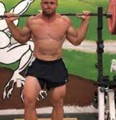How many reps and sets? Athlete Strength Training
BUILD YOUR OWN PROGRAM
Download our FREE Template by entering below

Rep Ranges For Athletes
Coaches and athletes (especially beginners) often ask what they need to do to become better athletes. They want to know the next crazy exercise, increasing a lift, or finding the best recovery tool. However, one thing that every athlete and coach can focus on is the rep. The foundation of every single training day is the number of reps for each exercise.
Best Rep Range
All rep ranges serve a purpose and are impactful. But if I have to be stuck with just one rep range to use and train, this is the rep range I’m going to use.
The best rep range is 3 to 5 reps. This is what we use the most in our Peak Strength programming.
Considering how myofibrillar hypertrophy gains help us get bigger, and blow up our strength. This range is great for Olympic-style weightlifters. They live in this rep range. Their quads are huge, their backs are yoked, and they’re strong, strong. They achieve myofibrillar hypertrophy and enhanced neurological coordination. This is what we want to achieve as athletes.
Analyzing the 3 to 5 rep range, we can start to figure out how many sets. For instance, we can figure out how many sets we need to do. Doing 3 reps of cleans, we can do six to eight sets to get the volume while holding great intensity. Think of the back squat. We can do seven sets of 5 reps to elicit a lot of adaptation with maximal strength.
What is great about the 3 to 5 rep range is it is perfect for technical coordination movements and absolute strength movements. The 3 to 5 rep range can even be useful with accessory movements. For instance, think of using Nordic hamstring curls to target the hamstrings. For plyometric and reflexive training, five sets of 3 reps is the most common rep scheme we use.
Applying The 3 to 5 Rep Range
The first applied system is based on step loading. Start with 3 sets of 3 reps all at the same weight at a high weight. The step comes into play when we will then do 3 sets of 5 reps right after. The goal is to have the first or second set of 5 reps is to hit the same weight the triples were performed at. The goal is to start to push the 5 rep max based on how the triples were loaded. This is a system that can be used for absolute strength.
Technical coordination exercises, 5x3 are pivotal. Same when talking about plyometrics. Hurdle hops, 5x3; stair jumps, 5x3; single-leg bounds, 5x3/3.
Let’s talk about wave loading. One of my favorite ways to use wave loading is having athletes doing a set of three then five then three then five then three. What happens is the body sort of gets confused and the five rep max gets pulled up because everything is being potentiated so well with the triples.
With accessories, think about doing four sets of five with Nordic curls. Or putting a heavy barbell on the back using the GHD to focus on extreme strength transfer from the hamstrings to the glutes into the lower back. The lower back strength will be enhanced using the 3 to 5 rep range.

The reason the rep is so imperative, outside having to do something to get a stimulus to adapt, is that the rep will show athletes and coaches where they are inside the training system. The rep will demonstrate what needs to be done. Doing a double means we’re in an intensity phase and trying to increase strength. With Parabolic Periodization, we would be inside the ascension phase or summit phase. Our focus is either on increasing strength with some drop-sets or we are focusing on the maximal increase of strength and we are performing eight to ten doubles. The rep dictates what we are doing in training and what type of response we are looking for out of training.
Understanding Adaptation The Rep Provides
The classic rules of thumb or the institutional standards around reps need to be evaluated for accuracy. Some are legit and some are sus.
Inside the rep range of 1-3 reps, we have our focus on maximal strength gains. Using this rep range we will see a lot of neurological adaptations. We will see intramuscular and intermuscular coordination and communication enhanced. This rep range will improve absolute strength and relative strength in most individuals and athletes. The 1-3 rep range is key to improving absolute strength.
Following the elementary principles of counting, the next rep range we want to speak to is the 4-6 rep range. In this rep range, we will still see some maximal strength gains and neurological strength gains. The maximal strength gain adaptations in the 4-6 rep range will not happen as well as it does in the 1-3 rep range, but it still occurs. In the 4-6 rep range, we will also see some myofibrillar hypertrophy which will improve the density of the muscle which over time will lead to hypertrophic gains while increasing max strength at the same time.
That then brings us to the 7-10 rep range, the classically known as the hypertrophic area where athletes are just trying to gain muscular mass. The conventional thought process is that the 7-10 rep range just puts on muscular size.
The 10-12 rep range is on the back end of the conventional thought of the hypertrophic gains. All the gains are seen as hypertrophic.
Anything above 12 reps is then seen as a strength-endurance focus. Some people say there can’t be strength gains or hypertrophic gains entering this realm of pain. Thankfully, this thought is starting to go by the wayside.
1 To 3 Reps
In this rep range, we might be doing technical coordination movements or absolute strength movements. The conventional wisdom around the adaptation that will occur in this rep range is an accurate analysis of the adaptation that will occur inside the athlete.
4 To 6 Reps
Same thing here with the conventional wisdom. The adaptations that occur inside athletes are typically myofibrillar hypertrophy gains, strength gains, and neurological enhancement. This is pretty accurate.

7 To 10 Reps
Here is where I don’t necessarily agree with most coaches. Most coaches will say this rep range is typically just hypertrophic. Yes, there will be a hypertrophic enhancement, but I believe this rep range will still enhance strength, especially if the rep is being manipulated. For instance, using speed movements or unbroken movements will cause the rep range to solicit a positive response to increasing maximal strength.
10 To 12 Reps And 12+ Reps
I will begin by saying that strength-endurance occurs here. But, I think strength gains occur within this rep range, especially if we are focusing on isolation movements. A lot of people forget that when we are breaking down muscles and we are isolating muscles and we have slow-twitch muscles, like the lat or erectors, doing 17 to 25 reps will target those muscles in a way that will enhance their strength.
This rep range will create an improvement in strength gains. There will be hypertrophic gains as well. But it isn’t just strength-endurance.


Recap
The rep is the key component behind every system. It is the key player. It tells you where you are inside of the training. The number of reps used plays a valuable role in creating adaptations within the body. It is important to remember that strength gains still occur in the rep ranges typically associated with hypertrophic gains; don’t be scared to venture into those 7+, 12+ and 17+ rep range areas to elicit adaptations.
And finally, remember the versatility in using the 3 to 5 rep range to train athletes at high levels (understanding overall periodization matters as well). In the end, we are always trying to increase strength, power output, and structural integrity. The rep ranges help make this happen.
If you still need help with programming and figuring out what rep ranges you need to use, try the Peak Strength app for a free week of training. Peak Strength will provide reps, sets, exercises, and weights so you don't have to guess on anything.
Related Posts
Blog Topics

Yo, It's Dane
Welcome to the Garage Strength Blog, where it is my goal to provide you with the experience and knowledge I've gained in the strength and conditioning world over many years of learning from both successes and failures. I train elite-level athletes in a multitude of sports from the high school to professional levels, already producing 5 Olympics and 30+ National Champions. If you want to be the next champion I train, check out my strength programs below!
Start Training With Me

Join for free educational videos EVERY WEEK on strength coaching and athletic performance



